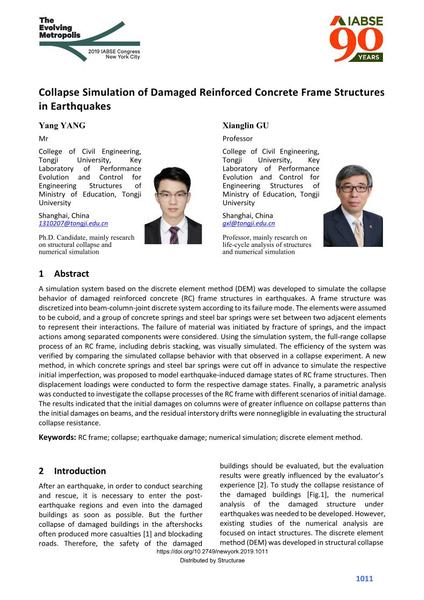Collapse Simulation of Damaged Reinforced Concrete Frame Structures in Earthquakes

|
|
|||||||||||
Bibliografische Angaben
| Autor(en): |
Yang Yang
(College of Civil Engineering, Tongji University, Key Laboratory of Performance Evolution and Control for Engineering Structures of Ministry of Education, Tongji University)
Xianglin Gu (College of Civil Engineering, Tongji University, Key Laboratory of Performance Evolution and Control for Engineering Structures of Ministry of Education, Tongji University) |
||||
|---|---|---|---|---|---|
| Medium: | Tagungsbeitrag | ||||
| Sprache(n): | Englisch | ||||
| Tagung: | IABSE Congress: The Evolving Metropolis, New York, NY, USA, 4-6 September 2019 | ||||
| Veröffentlicht in: | The Evolving Metropolis | ||||
|
|||||
| Seite(n): | 1011-1016 | ||||
| Anzahl der Seiten (im PDF): | 6 | ||||
| DOI: | 10.2749/newyork.2019.1011 | ||||
| Abstrakt: |
A simulation system based on the discrete element method (DEM) was developed to simulate the collapse behavior of damaged reinforced concrete (RC) frame structures in earthquakes. A frame structure was discretized into beam-column-joint discrete system according to its failure mode. The elements were assumed to be cuboid, and a group of concrete springs and steel bar springs were set between two adjacent elements to represent their interactions. The failure of material was initiated by fracture of springs, and the impact actions among separated components were considered. Using the simulation system, the full-range collapse process of an RC frame, including debris stacking, was visually simulated. The efficiency of the system was verified by comparing the simulated collapse behavior with that observed in a collapse experiment. A new method, in which concrete springs and steel bar springs were cut off in advance to simulate the respective initial imperfection, was proposed to model earthquake-induced damage states of RC frame structures. Then displacement loadings were conducted to form the respective damage states. Finally, a parametric analysis was conducted to investigate the collapse processes of the RC frame with different scenarios of initial damage. The results indicated that the initial damages on columns were of greater influence on collapse patterns than the initial damages on beams, and the residual interstory drifts were nonnegligible in evaluating the structural collapse resistance. |
||||
| Stichwörter: |
Einsturz numerische Simulation Erdbebenschäden
|
||||
